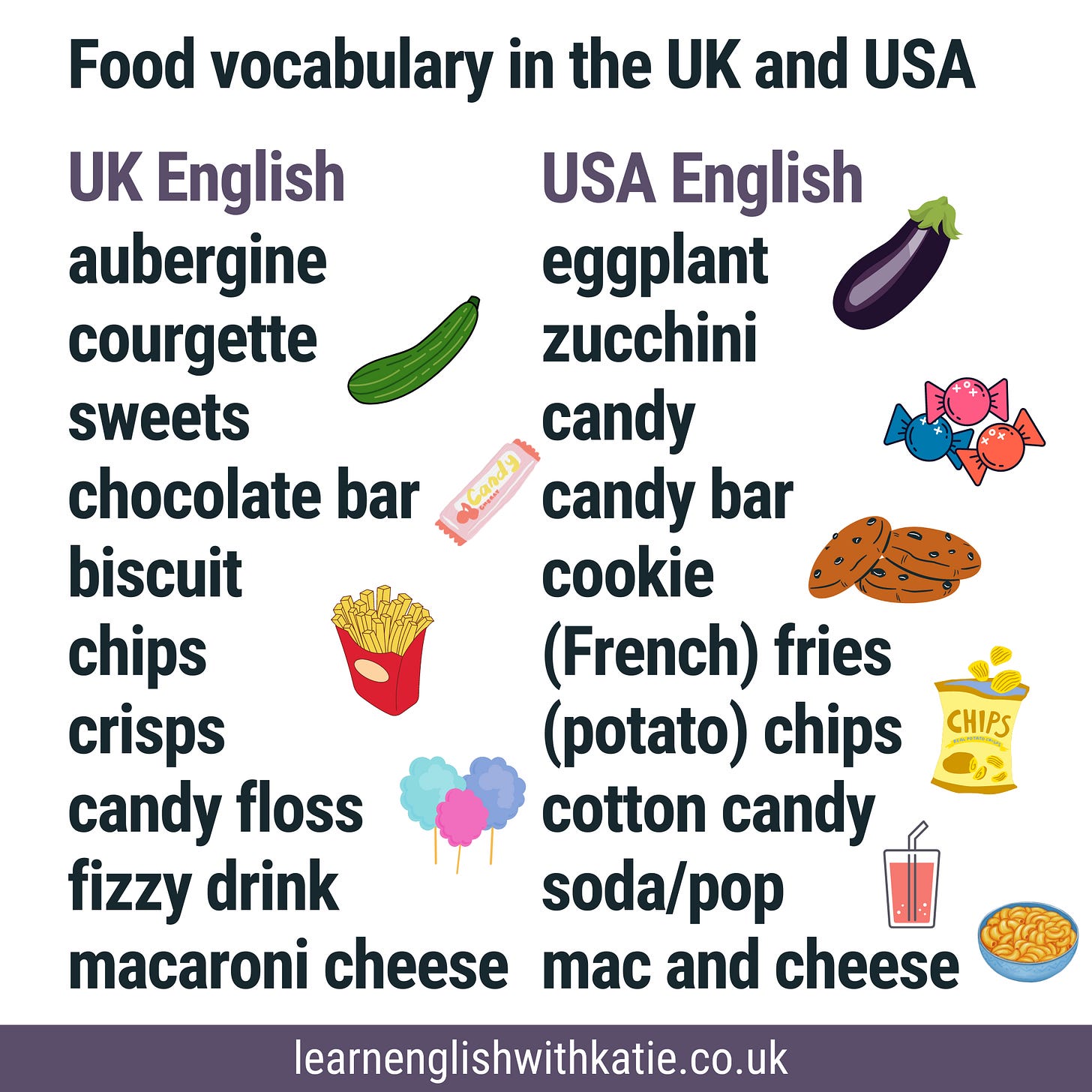
Hello everyone!
Learners often ask me what the difference is between British and American English. The biggest difference is probably in the vocabulary. We have different words for quite a lot of things, especially when talking about food. So today, I’m going to give you a list of some of these words. If you like watching films and TV shows, this information might be helpful!
One important thing you should also know is that sometimes we have different words for exactly the same thing while other times, the food is slightly different too.
And in case you don’t already know, I’m from the UK!
biscuit (UK) / cookie (USA)
A sweet baked treat which is often enjoyed with a cup of tea or coffee. The British version tends to be drier and crunchy, while American cookies are often soft and chewy. However, we can buy American-style cookies in the UK and then we use the American word.
scone (UK) / biscuit (USA)
In the UK, a scone is usually a slightly sweet baked item, sometimes containing fruit. They are often eaten with jam and butter or cream. We also have cheese scones, which are savoury. In the US, a biscuit refers to a type of savoury bread roll. It’s not exactly the same as a scone but has a similar appearance and texture.
chips (UK) / fries or French fries (USA)
Fried sticks of potato, served hot. In the UK, chips are typically thicker and softer compared to the thin, crispy fries found in the US. If we go to an American-style restaurant like McDonald’s in the UK, we do say the American word.
crisps (UK) / chips (USA)
Thin slices of fried or baked potatoes that are crispy and usually come in a plastic packet. They come in different flavours, such as salt and vinegar, or cheese and onion.
aubergine (UK) / eggplant (USA)
A dark purple vegetable with a smooth, shiny skin.
courgette (UK) / zucchini (USA)
A green summer vegetable. It looks similar to a cucumber but it’s usually cooked before eating it.
pepper (UK) / bell pepper (USA)
There are lots of kinds of peppers. In the US, a bell pepper specifically refers to the large peppers with a bell-like shape and a sweet taste. In Britain, we just call them peppers.
pudding (UK) / dessert (USA)
This is a sweet treat enjoyed at the end of a meal. In the UK, “pudding” can refer to any dessert, while in the US, “pudding” is a specific type of dessert similar to custard in the UK.
sweets (UK) / candy (USA)
Sugar-based confectionery that comes in various forms and flavors. In British English, the term “sweets” does not usually include chocolate, whereas the American word “candy” does include it.
chocolate bar (UK) / candy bar (USA)
A sweet treat made primarily of chocolate, such as a Mars Bar, Snickers, Twix or Kit-Kat.
candy floss (UK) / cotton candy (USA)
A fluffy, sugary confection made by heating and liquefying sugar and then spinning it into fine threads like hair. It’s often sold at a fair.
macaroni cheese (UK) / mac 'n' cheese (USA)
A dish made with macaroni, a kind of pasta, and cheese sauce.
fizzy drink (UK) / soda or pop (USA)
A carbonated drink like Coca Cola or lemonade.
jam (UK) / jelly or jam (USA)
In the US, jelly is a clear, fruit-flavoured spread, often spread onto toast or bread. It’s made from fruit juice and doesn’t contain fruit pieces. Jam is slightly different because it’s made with the whole fruit. In the UK, both of these would usually be called jam. British jam usually contains fruit but you can buy seedless jam.
jelly (UK) / Jell-O (USA)
In the UK, jelly refers to a dessert made from gelatin and fruit juice, similar to what is known as Jell-O in the US.
ice lolly (UK) / popsicle (USA)
An ice lolly in the UK is a frozen treat on a stick, usually made from fruit juice or flavored water. In the US, a similar frozen treat is called a popsicle.
bill (UK) / check (USA)
In the UK, the bill is the piece of paper which tells you the cost of a meal in a restaurant, while in the US, it's referred to as the check.
takeaway (UK) / takeout (USA)
This is food which is prepared by a restaurant or fast-food place to be eaten somewhere else, often at home.
These are just a few examples of how food vocabulary can differ between British and American English. I tried to choose the most important ones for you.
Until next time!
Katie
PS: If you’d like to more about the differences and about which variety of English you should learn, you might like this post from a few weeks ago:





I'm really appreciative of what you did.
Thanks for sharing this important reflection with us!